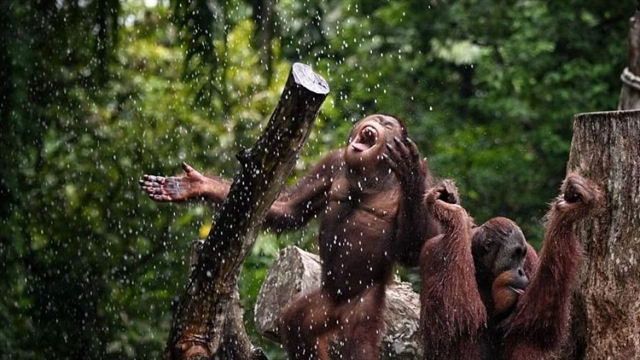 Life & Style
Life & Style

With El Nino’s warmth projected to make the already warm months of April and May even hotter, zookeepers are monitoring the animals even more closely to ensure they are coping well with the higher temperatures.

|
| Orang utans Adi (left) and Bino enjoy the spray of cool water to help them cope with the sun and heat at the Singapore Zoo. The Straits Times Photo |
SINGAPORE – Adi looked like he was doing a rain dance.
With the sun hanging high overhead, the Bornean orang utan did a little jig with his arms stretched high towards the sky.
Soon enough, the “rains” did come, and Adi welcomed the cooling water with his mouth wide open.
These showers were not from the heavens, but from hoses wielded by zookeepers at the Singapore Zoo.
With El Nino’s warmth projected to make the already warm months of April and May even hotter, the Zoo is rolling out a raft of measures – including hosing down their animals more often – as a respite from the heat.
“Ice-based enrichment”, or fruits and vegetables frozen in ice blocks, are also given to the animals to keep them mentally and physically engaged during hotter periods, said Dr Luis Neves, vice-president of animal care at Mandai Wildlife Group, which manages the four wildlife parks, including the Singapore Zoo.
Zookeepers also ensure that animals always have access to fresh water within their exhibits, he said, and animal care teams monitor the animals under their charge closely.
“Besides ensuring sufficient shade in the habitats and providing water sources, we adjust activities such as outdoor training to earlier or later parts of the day when it is cooler, where necessary,” Dr Neves said.
Dr Neves was responding to queries from The Straits Times, following ST’s earlier report on March 31 that highlighted how April and May – among the warmest months of the year – could get hotter due to the lingering effects of the climate phenomenon known as El Nino.
He added that measures to keep animals cool had been built into the wildlife habitats and support areas, given Singapore’s location in the tropics. He said: “The animals are provided with a variety of shaded areas within their habitats and access to support areas.”
These support areas are places located at the back of each exhibit, where the animals can sleep and rest. Most of these support areas are installed with fans to cool the animals down and hoses that the zookeepers can switch on to provide the animals with showers when the days get hot.
But Dr Neves noted that some animals – such as orang utans, elephants and pigs – are more vulnerable to heat. These animals have certain features that make them more prone to overheating, such as thick body hair, or the lack of sweat glands.
Zookeepers monitor these animals even more closely to ensure they are coping well with the higher temperatures.
“Orang utans have thick body hair coats, which can cause their core body temperature to rise and overheat if exposed to elevated temperatures for prolonged periods,” said Dr Neves.
Head zookeeper Jeremy Chew, 50, said his team monitors the orang utans closely and hoses them as and when required, more so during the warmer periods.
Zookeepers also actively look out for signs of heat stress, including panting, a lack of appetite and ruffling of body coat fur or feathers, according to Dr Neves.
“Checks are conducted daily, with increased frequency for species that are more vulnerable to heat such as orang utans, elephants, pigs, as well as younger and older animals regardless of species,” he said.
As for elephants and pigs, these animals do not have sweat glands, so their bodies have difficulty regulating temperature under prolonged exposure to extreme heat, Dr Neves added.
During a particularly sunny afternoon on March 20, Asian elephants Aprila and Gambir were seen digging into their icy treats.
Using their trunks, they would drop blocks of ice filled with fruits and vegetables onto the ground, so that the blocks would shatter into chunks of icy watermelon, carrots and durians, making it easier for them to munch on the sweet treats.
Red river hogs enjoy their frozen treats just as much as the elephants. Chari and Chinko – who are brothers – were observed biting into and breaking the ice blocks to get to the carrots and honeydew slices embedded within.
The habitat in which the red river hogs reside includes a small pool where they can swim and play in, as well as support areas where they sleep and rest. The Straits Times/ANN




